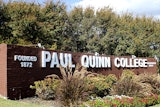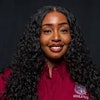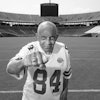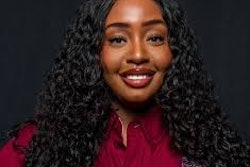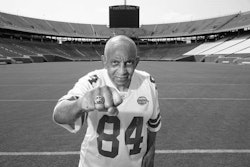WINSTON-SALEM, NC – Expert panelists at the “Losing to Win: Discussion of Race and Intercollegiate Sports” conference turned their attention partly to the media coverage of minority student-athletes and did not shy away from addressing accusations that media outlets do not always fairly scrutinize Black and other minority athletes. Panelists also decried the lack of minorities working as sports reporters, producers, and editors and admitted the numbers are getting worse, not better.
“We don’t always get it right,” said Tom O’Toole, the prep sports editor at USA Today, in reference to frequently uneven treatment of African-American athletes in the press. “When (reporters) would write stories, and I’m sure that I have been one of them, we would write ‘in code,’” O’Toole said.
“We would say the articulate (player) or the well-spoken (player),” when speaking of an especially intelligent athlete of color. And unfortunately some of these code words still exist today. You’ve heard some of this: Black players are called ‘athletic’; White players are called ‘hard-working … and scrappy.’ There are questions that are asked ‘in code,’ too,” O’Toole said.
The reporters may not think that such writings or their questions are racist in nature, he said, but they are.
Dr. Kevin Blackistone, a sports columnist and frequent panelist on ESPN who currently holds the Shirley Povich Chair in Sports Journalism at the University of Maryland, gave several examples of portrayals of Black athletes in the media and decried the absence of Blacks in newsrooms.
“New media today looks a lot like old media,” he said. “It is owned by Whites and run by Whites who have a proclivity to hire their own. Press rooms and press boxes at major college athletic events in particular are increasingly all-White to the eye. I’ve certainly been in press boxes in the past year or year and a half where I was the only person of color – at least not representing maybe a college newspaper or a college radio station.”
Blackistone said there are “consequences of an increasingly less diverse …, more White sports media covering what is unquestionably a more diverse and … more Black and Brown major-sports-team universe.”
“There are the concerns proved by research over the years that Black athletes who dominate major sports like pro and college football and basketball are portrayed negatively and stereotypically by mostly White media. There are concerns that this development will continue to heighten anxieties about Black males in society in particular,” Blackistone said.
Hosted by Wake Forest University, the two-day conference ended Thursday. The event, which brought together nearly 50 speakers from academe, sports (current and former administrators, coaches, trainers and players), media, law, and social work, sought to raise the national consciousness about racial issues in big-time college athletics.
With regard to recruiting, coaches and athletes on one panel talked about the need for prospective athletes and their families to be armed with questions to ask recruiters and to have a game plan to learn information when visiting colleges. Brenda Mock Kirkpatrick, an assistant women’s basketball coach at the University of Florida, reeled off some of those questions parents should think about: What challenges will athletes face on a particular campus? How is the college selling itself? What are a school’s athlete and general student graduation rates? What are its graduates doing? If the athlete is African-American, what type of reception is he or she likely to get?
Cory Randolph, a former football player at Wake Forest, recalled his own recruitment.
“It becomes a nightmare because … as you begin to become a better prospect, more and more you see the increase in telephone calls and mail and other contacts, and I’ll never forget … one night I think we had 20 to 25 calls, and my dad wanted to put me out of the house or to get another phone line because he said this is just absurd. These coaches come in and literally take over your life. It becomes all about recruiting,” he said.
“Going through this whole recruiting process, the one thing I’ve learned is trust,” Randolph said. “Know whom to trust, and know to trust yourself. You’ll go to different schools and you’ll think you like one place, but you’re not sure. But at the end of the day, there’ll be this feeling that you’ll know, this is the place for me. This institution and these coaches and this staff have my best interests at heart, and that’s the place you need to go.”
“After we leave here today, our job is to go out and continue to do our work in order to help improve college athletics and make it more multicultural in every sense,” said Dr. Emmett Gill, an assistant professor in the Department of Social Work at North Carolina Central University. Gill, among those at the conference who advocates additional compensation for college athletes beyond their scholarships, also tackled the need to clean up recruitment of athletes and to discuss honestly the interplay of academics and athletics.
“We need to do better,” he said.
The conference concluded with an inspiring talk from former Wake Forest All-American basketball player Rodney Rogers.
Rogers, who was seriously injured in a 2008 dirt-bike accident that followed his nine-year NBA career and left him paralyzed from the shoulders down, spoke from the stage in his wheelchair and using a ventilator.
Having grown up in a housing project in Durham, N.C., Rogers spoke of his transition from his mostly-Black Hillside High School to the mostly-White student body at Wake Forest. “It was basically a culture shock,” he said. “The only thing I didn’t like was that some professors didn’t think we (athletes) were here except to win (games). I said ‘judge me as a student, because that’s what I’m here for.’”
Surviving the accident, Rogers created the nonprofit Rodney Rogers Foundation to assist others experiencing paralysis because of spinal cord injury, raising financial support for patients who cannot afford the cost of rehabilitation. Rogers’ own care costs $400,000 a year.
